#another one mimicking my ms paint style
Explore tagged Tumblr posts
Text

Nother Commission in my chunky style
#commission#furry commission#commissions#art#my art#artists on tumblr#drawing#anthro#safefurwork#sfw furry#anthro art#another one mimicking my ms paint style#i am geuinelly confused that people keep asking for this style#i looked at my ms paint sketched from this year around and find my regular pieces just so much better than them? maybe its bc the style is#more unique? I do like this piece a lot! but IDK its just strange#ive been trying to define my style more for -professional marketing reasons- so maybe i should stick with something more unqiue?? IDK
189 notes
·
View notes
Text
Cataloguing Homestuck’s Art Styles
Hussie deploys a number of distinct art styles throughout Homestuck, each serving different purposes in the narrative. A number of these, especially those mentioned in the published book series’ author commentary, have been catalogued in the Homestuck wiki [1]. These officially named styles are well-known enough to appear in quora answers. However, Homestuck employs a much larger variety of stylistic manipulations than explicitly mentioned in the book commentary or wiki. While scanning through the comic again for this project, I wanted to catalogue the rest of them!
This post constitutes a working list of all distinct art styles present in Homestuck. I’ve chosen not to include the distinct styles of the fanartists/outside artists who contributed to the comic; that will be a project for another day. As far as I know, this list only comprises the different styles Hussie develops throughout the comic. I have tried to bring a degree of specific formal analysis (also known as art-historical language) into my description of each style.
1. “Classic” Style
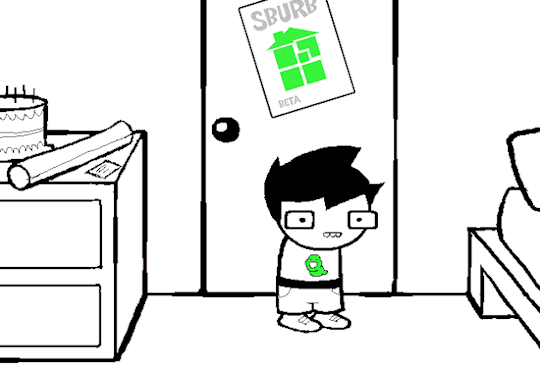
Page 1 of Homestuck

Page 1349 of Homestuck
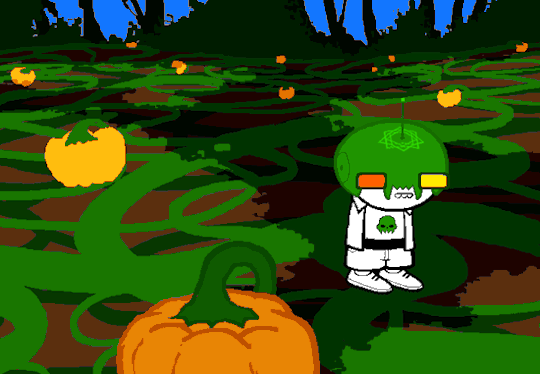
Page 4227 of Homestuck
The “Classic” Homestuck style appears on the first page of the comic. Although not officially described by the wiki, it is widely understood as the comic’s typical graphic norm. Characters have simplified faces and clothes, and they frequently lack arms. Elements are often outlined in a black stroke, especially to differentiate them from other adjacent, similarly-colored elements. In more colorful panels, scenery may be made up of solid blocks with bright colors. Sprites (base character illustrations) and elements are repurposed from panel to panel in new combinations. Homestuck even takes up the repurposing of sprites as a gag, as in page 1349 above where the ability to flip one’s sprite allows Noir to regain his lost wrist barcode.
This style obviously shares characteristics with Hussie’s style in Problem Sleuth. General characteristics that frequently appear in Hussie’s art are present, such as circular faces and rounded edges on quadrilaterals. The Classic Style umbrella actually covers the broadest range of visuals out of any style catalogued here. The uber-simplistic sprites, such as John on page 1, have typically been lumped in with, for example, the illustration on the cover of Homestuck Book 1, or the two other examples I pulled for this post. So, in the Classic Style, characters can sometimes appear with arms, sometimes without, and in outfits of varying detail, but they retain the same facial features and simplistic quality. The circular facial shape is especially characteristic of this style, along with the lack of a neck. The neck-less quality, static poses, and simplistic detail chiefly differentiate some instances of Classic Style from Hero Mode, though there are still some grey areas.
2. Scribble Mode

Page 1931 of Homestuck

Page 1937 of Homestuck
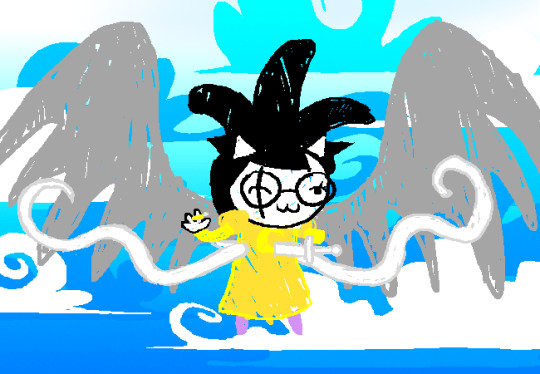
Page 1798 of Homestuck
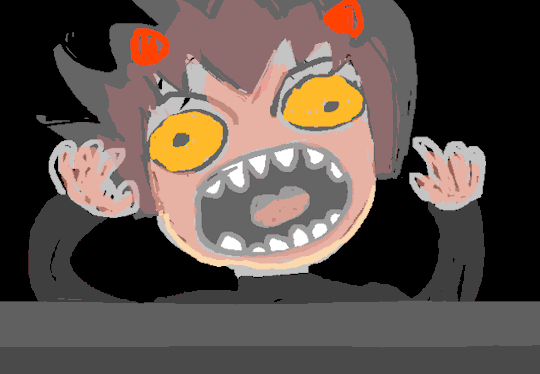
Page 3140 of Homestuck
This style is recognized by the Homestuck wiki, which describes it as emphasizing “a particularly silly/stupid moment in the story, particularly those to be imagined by a character.” That is to say, this style often denotes imagined scenarios which do not actually occur in the comic but instead in a character’s imagination, and especially those which form the butt of jokes. It is also employed simply to highlight silliness. This style is constructed to appear as if the author has “scribbled” rapidly between the outlines of forms to fill in color, creating gaps in those forms. Generally, strokes are made to seem more careless, and less detail is used. While the style is meant to mimic a scribbling motion, it does not always end up crude or parodic. For example, in this “charming vignette” (in Hussie’s words) depicting the Mayor’s dream, the scribble style actually illustrates a remarkably beautiful and almost impressionistic series of panels. Although the dream vignette has certain obvious scribbley elements and certainly depicts an imagined scenario, I would argue that it combines aspects of both Scribble Mode and Hussnasty Mode (#4 in this post) throughout.
I have also identified two distinct styles within the Scribble Mode umbrella. One always uses a thin, apparently single-pixel-wide black line to outline forms, while the other uses a thicker stroke for both its filling and outline. You can see the difference between these in the four examples I’ve pulled; they are sometimes even combined within one single Scribble Mode panel.
3. Hero Mode
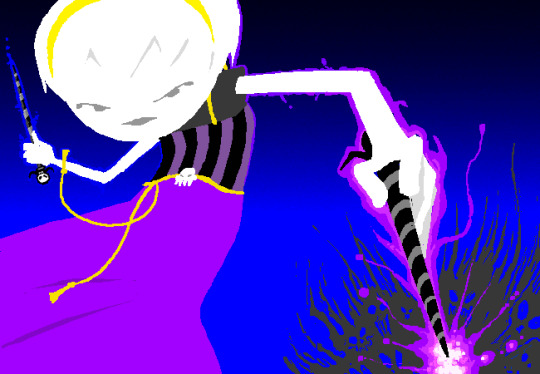
Page 1815 of Homestuck

Page 2063 of Homestuck
Hero Mode was officially named as such by Hussie. The Homestuck wiki page describes it as cropping up to “emphasize a particularly epic moment in the story.” Hussie originally called the style “action panels” before hitting upon the current name, emphasizing the link to action scenes and dynamic poses. Along with dynamic posing, characters are drawn in greater detail and tend to have elongated limbs. Some crossover can be seen between Hero Mode and Hussnasty Mode. I would argue that characters in Hero Mode usually retain the original style’s characteristic lack of a neck, while Hussnasty Mode often adds one. Compared with the Classic style, Hero Mode always adds arms. The degree to which Hero Mode drawings include the “hatching-type effect” characteristic of Hussnasty Mode varies from panel to panel. The difference between Hero Mode and Classic Mode can be observed clearly on these two pages, where Damara shifts between the two styles at the behest of Scratch, who asks her to “render [herself] in a more symbolic manner.”
The wiki asserts that “Hero Mode dispenses with the black outline that typifies sprite-style animation and scribble mode,” but I don’t think it can actually be characterized as the only lineless style. Scribble Mode and Hussnasty Mode also sometimes feature a lineless graphic style depending on which part of a character is being depicted, or the need for a line to differentiate two features of a similar color. A willingness to move between lined and lineless blocks of color characterizes Hussie’s art as a whole.
4. Hussnasty Mode
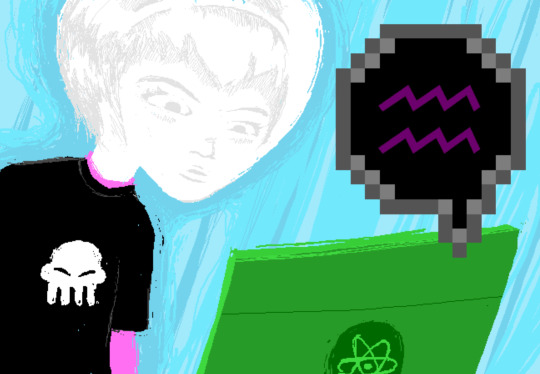
Page 2805 of Homestuck
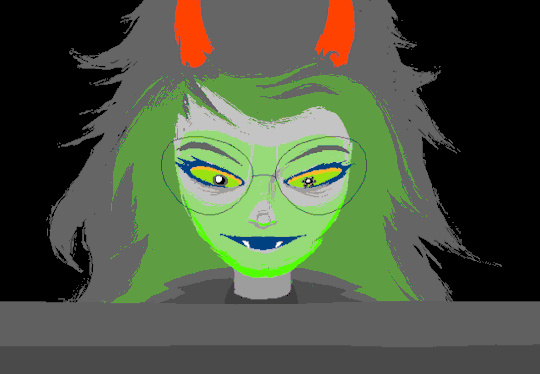
Page 2976 of Homestuck
This art style is also named by the author. In his commentary on page 2805, he writes: “Someone asked me what I called the style, and I replied by naming it "Hussnasty Mode" myself, because well… it's a bit nasty, isn't it? Kind of raw, a little over-illustrated, and making use of a lot of jagged aliased pixel edges for a hatching-type effect. It was sort of the point to make it a little nasty, kind of aggressively incongruous with the other styles previously established.” This quote sums up the style’s characteristics pretty well. Hussie also describes how this style is more naturalistic, or less symbolic, and was meant to work in direct contrast to the extremely symbolic RPG Sprite Mode. He writes that “drawings like this are introduced in contrast with this simple RPG sprite mode, which was also established very recently as something that Homestuck was "allowed" to use as a stylistic presentation of characters and settings… Every time HS does something like this, it's widening its own umbrella in terms of what it's allowed to do stylistically, which includes dramatically simplifying and abstracting its forms. Which implicitly asks another question: Can HS "allow" itself to go in the other direction? To render characters with higher degrees of definition, regardless of congruity, and freely navigate this full artistic palette at any time, resulting in sharp stylistic contrast and a certain amount of visual thrashing? The answer to that question, almost immediately after it's asked in the form of dropping RPG-sprite Rose into a standard panel shot, is yes, HS can do that, and clearly it WILL do that.”
5. RPG Sprite Mode
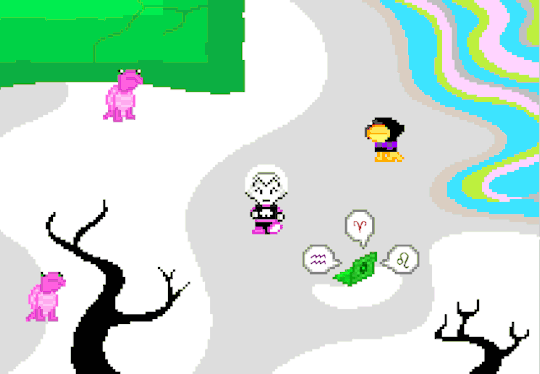
Page 2804 of Homestuck
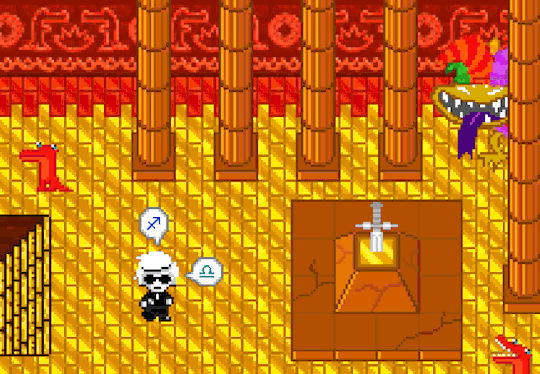
Page 2824 of Homestuck
Despite being officially described by the author, RPG Sprite Mode hasn’t gained much representation as a distinct style (it does not have a wiki page, for example). This style appears after Homestuck’s first walk-around game, now incorporated as a style for static or gif panels. After their joint introduction, this style is juxtaposed against the Hussnasty style. The quotes pulled above in the section on Hussnasty Mode nicely describe the contrast between these two styles and their greater impact on Homestuck’s graphic norms. RPG Sprite Mode always shows characters from an aerial view, mimicking the style of the first walk-around game, which in turn mimics a wealth of RPG sprite games (such as the original Pokemon games). Sprites from these sorts of early games can be characterized by their almost pointillistic use of individual pixels to carefully construct forms.
6. Terezi’s Perspective

Page 2756 of Homestuck
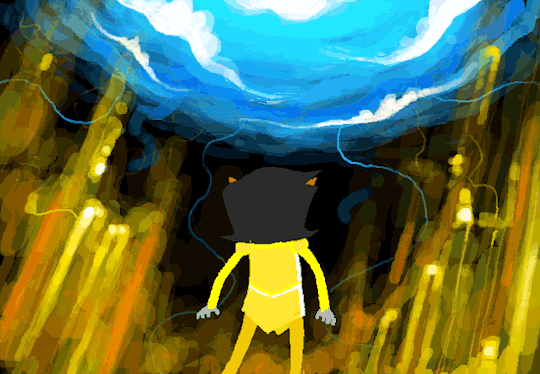
Page 2128 of Homestuck
This style hasn’t been officially described yet. It only crops up as a representation of Terezi’s perspective, conveying some of her experience tasting and smelling colors. While it only appears a few times in the comic, I think it is uniquely visually interesting, and it includes “blurring” techniques which are only rarely employed in the rest of the comic. I’d guess that the effect is created by layering low-opacity strokes over one another and then sliding the different layers’ opacity up and down.
7. SBAHJ Style

Page 8 of Sweet Bro and Hella Jeff
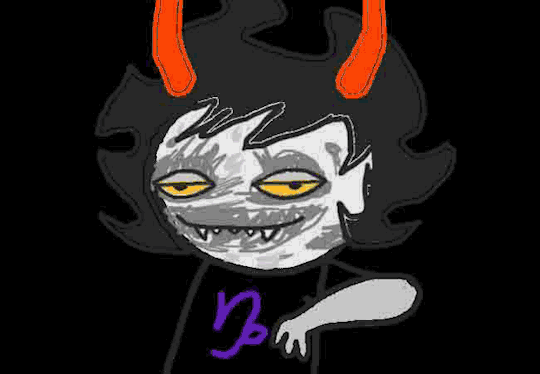
Page 3451 of Homestuck
The SBAHJ comic, featured both within Homestuck and as a spin-off, has its own recognizable style. In the first few pages it has a lot of commonalities with Homestuck’s two versions of Scribble Mode, but later takes on distinct characteristics. It can be characterized in part by its image clipping, an effect where an element is made to look like it has been selected within a square box (in MS Paint or Photoshop) and dragged around the page with little care for the size and accuracy of the selection box. Commenting on page 3451, Hussie describes this effect as follows: “In the SBaHJ comics, one of my cool tactics—which I'm almost positive I invented as a sequential artist—was to elaborately render someone ‘turning around’ by taking one shot of them and gradually altering the pose by crudely rectangle-selecting pieces of their face and nudging them around until they're facing the other way in a totally unconvincing and utterly hideous manner.” Different from Scribble Mode, the SBAHJ style also frequently features blocks of color that appear to be filled with the “paint bucket” tool. When the paint bucket tool is used to fill anti-aliased stokes, it creates a small transparent space between the filling and the original outline, visible in the SBAHJ graphics. Finally, SBAHJ comes to include image compression and glitching, created through “deep frying” compression techniques. Overall, the breadth of manipulative techniques made apparent to the viewer in SBAHJ is much greater than any other style. SBAHJ panels are reproduced wholesale or hyperlinked in Homestuck, but on these two pages Gamzee is also drawn in the SBAHJ style.
8. Caliborn’s Styles

Page 5075 of Homestuck (hyperlinked in pesterlog)
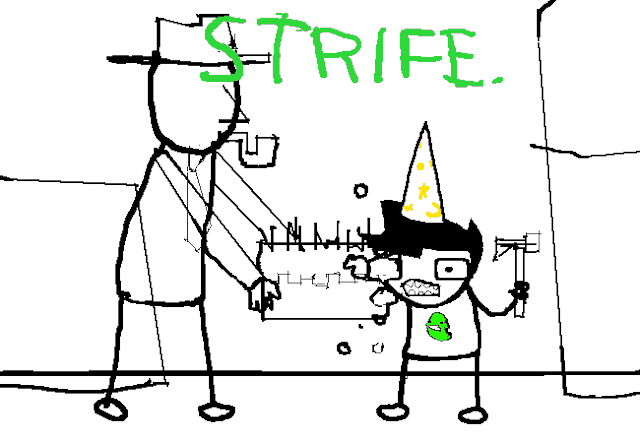
Page 6259 of Homestuck

Page 6929 of Homestuck
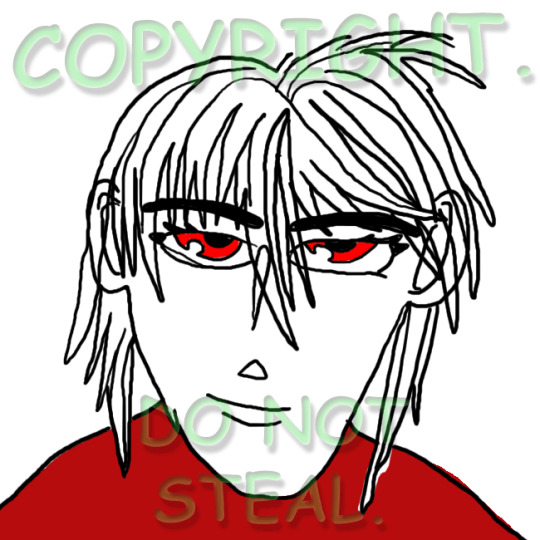
Page 6864 of Homestuck
While Calliope’s in-world art was contributed by Shelby Cragg, Hussie gives Caliborn has three styles of his own. The first is his “angular” style, which Calliope aptly characterizes on page 5109 as containing “inscrutable squiggles” and demonstrating a “penchant for arbitrary, completely baffling straight lines and right angles, almost as if trying unsuccessfully to begin constructing a grid.” The second is the style he uses in Homosuck, which retains elements of his original “baffling right angles” but generally takes on the black outlines characteristic of Homestuck’s Classic style, while employing even cruder detail. Finally, after reading a “How to Draw Manga” book, he develops his “manga” style which uses black strokes, somewhat messy coloring (usually with the paint-bucket tool), and shows an attempt at naturalistic representation despite a complete lack of understanding of human anatomy. This style is specifically meant to emulate manga styles, so it features the characteristic white dots as highlights in the eyes, among other features.
————————————————————————
As becomes apparent through Hussie’s commentary, the different art styles employed in Homestuck do more than just emphasize certain moments; they form part of the comic’s visual language and ask us to question our understanding of graphic representation. The scope of this post also illustrates the attention paid to Homestuck’s visual elements throughout the story’s production and within its readership, even if these visual distinctions have received less attention in scholarship. Despite the variety of styles, we can see Hussie’s characteristic artistic tools, techniques, and sensibilities reflected across the comic.
If you find any styles recurring in the comic that I haven’t mentioned here, feel free to shoot me a message! Again, I haven’t included styles from other contributors; only those developed and drawn by Hussie.
————————————————————————
As we approach the close of the semester, I’ll probably be putting out one more post sometime soon! If you liked this post, you can follow the blog on tumblr for updates or, if you don’t frequent tumblr, sign up for the mailing list to receive an email whenever I publish a new mini-essay!
————————————————————————
[1] These include Hussnasty Mode, Scribble Mode, and Hero Mode.
92 notes
·
View notes
Text
Backstory time
A few people seem interested, so I’ll tell about how I got back into drawing as an adult ^^
I loved drawing in elementary school and a bit in middle school, but then i just...stopped. I don’t remember why. That was around 2005.
Fast forward to my first year of college in 2011. That’s when I got into deviantArt, zelda ask accounts there, and my first online friends due to that community. I was really lonely being away at college, so talking to these other kids felt so nice especially since my two roommates were awful to me.
Like I mentioned, I LOVED the zelda ask accounts. I’d just gotten into the game series that year, so it felt like I was talking to celebrities when I’d ask them questions. It was all in good fun, ofc. Then, in December, the girl who ran the ask accounts for both Blue Link and Dark Link decided to quit and pass on the accounts to someone else. Out of the blue, she asked me to be the new Dark Link. (This is where my online nickname comes from.)
I hadn’t drawn in years, yet she trusted me to take good care of her accounts. I was incredibly flattered, especially since she was very picky and we didn’t talk much. Others weren’t too happy only because another girl was supposed to be Dark Link. It was okay though; she took over the Blue Link account; she and I met that way, and we’re still friends to this day <3
Now, running an ask account for a character did a lot to change my life. It got me back into drawing, really pushed my roleplaying (which is now my favorite hobby), found me new friends, etc. But I’m only here to talk about the art aspect.
So...I didn’t know what to do! I hadn’t drawn in six years! So I grabbed a pencil and some paper and made a sample Dark Link before I began answering questions (Dec 2011):
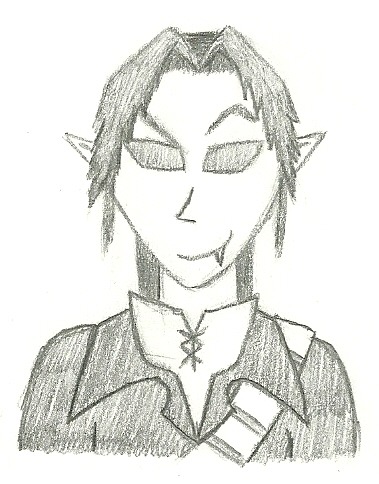
y i k e s
Oddly, my second attempt looked very different, and i used it for my first answer (Dec 2011):
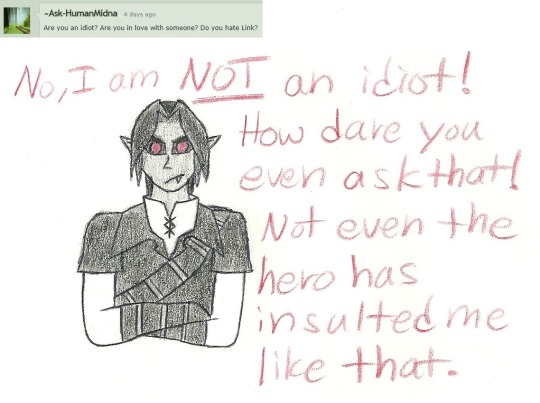
All i had at the time were mechanical pencils (which i pressed into the paper too hard), some crayola colored pencils, a sharpie for line work, and computer paper (since it was easiest for me to place onto our computer scanner). I looked up references like crazy, and I’d flip over my paper and hold it up to the light to check for mistakes. After I’d scan in the drawing, I’d use a simple photo software that was already on the computer to make the background pure white, and then it’s use MS Paint to fix any line art blemishes I could.
People liked me and I got closer to the friends I’d made, so i had the confidence to keep going! Also, it was a goal of mine to answer more questions than the previous account holder had.
It took until my 13th answer for me to try a 3/4 view rather than straight on (June 2012):
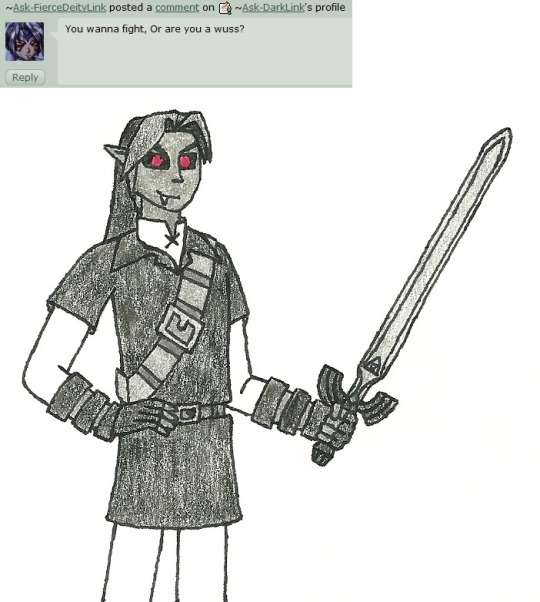
And I felt so proud of myself!
Fast forward three years, and my 34th answer (thought not my 34th drawing for the account) was when I really felt like i’d finally gotten a handle on drawing DL (March 2015):
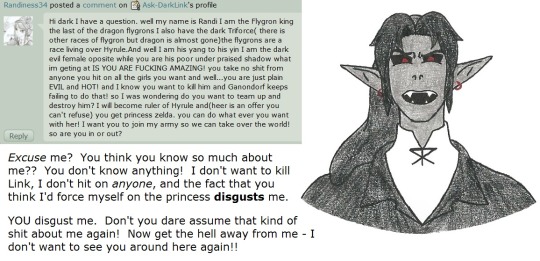
Plus, answering this asshole AS an asshole was entirely satisfying >>;;
A year later, a friend i met in the community gifted me her old tablet, so i was able to start drawing digitally for the first time! To celebrate, I drew OoT Link as my first drawing (Jan 2016):

It felt incredible seeing my colors look so smooth rather than grainy. Lining still looked grainy, though, and took a million times longer. Also, having a plethora of colors to choose from was pressuring. But overall, i enjoyed the luxuries of using Sai (which i still use) over using paper.
Back on my Dark Link account, it took until answer 38 for me to draw digitally. But before that, I had done two AU designs for Dark Link and my first collab! I was feeling like a real artist! On my main account, I drew some pokemon, which allowed me to practice both lining and shading. Mewtwo was my first digital shading attempt (Feb 2016):

Shading was kinda fun, but i was so obsessive over the line art, that it took me hoouurs. It was awful, and i felt like i’d never get faster, though my friend who had the Link ask account encouraged me and gave me advice. As you’ve seen, my line art got much smoother, and i eventually stopped shading unless i was really in the mood since i didn’t enjoy it enough to make it worth all the effort and time. And speaking of time, my friend was right; i’ve gotten much faster now. It may still take me a few hours to sketch a bust sometimes, but that’s better than, say, a few days instead.
I began drawing for other fandoms; just fanart of characters I liked ^^ And i got my first commission in May of 2016. It blew my mind!!
Okay this is a small break in flow, but here is one of my last drawings of Dark Link i did for that ask account to bookend my development in drawing him vuv (Oct 2016):

Handsome boy. I still drew perfectly round irises back then, I just noticed. ...And I never really ended up understanding how to draw his hair lol oh well.
Anyway, when Splatoon came out in 2015 (taking a step backwards in my timeline for a sec), my friends i played with turned the squids they regularly played as into OCs, and i did the same so i could join in. That was my very first OC. And because of this, because of having my own character to develop and love and share, i got insanely obsessed and drew more and more and more.
If you paid attention to my drawing dates up above, you’ll notice my OC creation began before I got my tablet. Boy was it rough figuring out how to draw inklings when you’re an amateur artist with only a pencil. I’d show my development in drawing inklings, but that’s pretty specific and in too tiny of a time frame. Buuuut I can at least share my first attempt, mimicking the game’s style (Dec 2015):

Cute!
Aaand my second attempt, using my own style (probably a few days later):

Not cute lmao
I almost quit bothering to draw inklings after that, but then I got the tablet! And that tablet made me feel like i could draw anything. Sometimes, it still does... I mean, look at what i’ve been accomplishing lately (Dec 2016; Sep 2016):
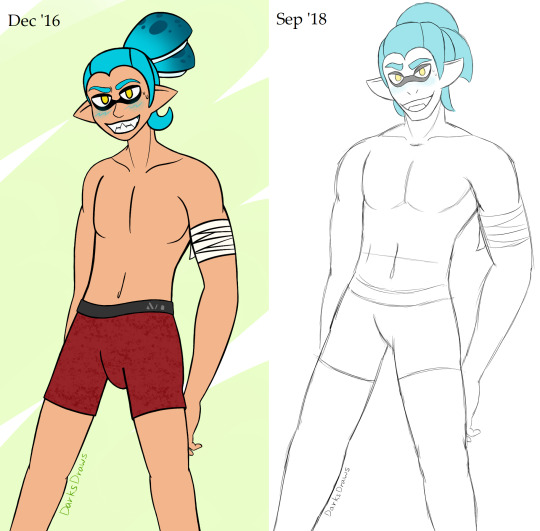
I’m sure you guys remember this comparison i posted last month, but come on.
Anyway, here’s where i am today! I guess what i was lacking as a kid was a real passion for a subject. Well, i had a CRAZY crush on Danny Phantom in elementary school(?), and I drew him a lot lol, but then I didn’t have anything after him. But once i found zelda and splatoon, i had reasons to draw again. Being able to bring my characters to life through my art is more satisfying than i can explain.
...And being spontaneously given a drawing account to keep up with is a fantastic shove in the right direction lmao
#i probably forgot some chunks but it's a miracle i even remember THIS much#i only had 4 hours of sleep so i hope this is an easy read#not art
6 notes
·
View notes
Text
‘How Am I Going to Dance to This?’ Ratmansky’s New Music Frontier
Alexei Ratmansky walked into the studio and got out his phone. It was the first rehearsal of his latest work for New York City Ballet, and the dancers were waiting eagerly to find out what he had in mind. He pressed play, and a woman’s voice and a piano, mimicking her vocal intonations, filled the room. “This is the music,” he told the assembled dancers.
“We were like, what?!,” the dancer Sara Mearns said. “How am I going to dance to this?”
“He also said, ‘There is no musicality, just your own,’” Ms. Mearns continued after a recent rehearsal. “In working with him on a whole bunch of ballets, all super connected to the music, it was the first time I had ever heard him say that. I thought, who is this person?”
“Voices,” set to Peter Ablinger’s “Voices and Piano,” which will premiere at City Ballet’s New Combinations evening on Thursday, is a new frontier, musically, for Mr. Ratmansky — known for witty, poetic physical responses to more conventional scores and sensitive reconstructions of 19th-century classics.
Like most ballet choreographers over the past few hundred years, he has taken musical melody, theme and structure as the impetus for the creation of movement. In this, he follows squarely in the footsteps of George Balanchine, the co-founder of City Ballet, whose saying, “see the music, hear the dance” is still an in-house mantra.
Mr. Ratmansky, 51, has created ballets to Shostakovich, Stravinsky, Prokofiev and other Russian composers, as well as Scarlatti, Strauss and Bernstein. He has previously worked with only one living composer, the Ukraine-born Leonid Desyatnikov, whose melodic, often folk-inspired music Mr. Ratmansky has used for six ballets.
But Mr. Desyatnikov’s music is far from experimental or especially challenging. Mr. Ablinger’s “Voices and Piano,” on the other hand, is not what you would think of as dance-friendly. The short pieces consist of a single recorded voice and a piano that (mostly) imitates the tonalities and vocal patterns of the speaker, forming a rhythmically idiosyncratic, unpredictable soundscape. (In a few sections, Mr. Ablinger takes another route and sets the piano between the spoken utterances.)
Why did Mr. Ratmansky suddenly move onto experimental new-music terrain? “I felt like I needed a shake-up,” he said in an interview after a long rehearsal of “Voices.” “In the last couple of years, I have done ‘Harlequinade,’ ‘Bayadere,’ ‘Giselle,’ all set to those well-known, traditional scores. For this particular project, I wanted something totally different.”
He asked his son, Vassily, a music composition student, to suggest some possibilities. “Voices and Piano” was among them; it immediately resonated. “Because of the sound of the voice, and how the composer reflects that in the piano,” Mr. Ratmansky said, “it’s not abstract, it’s full of color and warmth and emotion.”
Mr. Ablinger, 60, is an Austrian-born, Berlin-based composer, who to date has written 60 short pieces in the “Voices and Piano” series, which he describes as his song cycle. (The most recent, “Diamanda Galás,” premiered in Chicago on Jan. 23). The voice extracts he has used come from a wide range of personalities (Marina Abramovic, Mao Zedong, Gertrude Stein, Mother Teresa, Jean-Paul Sartre) as well as unknown figures. “The voice has to have a relation to me of some sort,” Mr. Ablinger said in a telephone interview. “It could be because I have read their books or listened to their music, or just a voice that touches me.”
Mr. Ratmansky said he listened to what he could of Mr. Ablinger’s output, and decided to stick to female voices because he could see a clearer structure for the work that way. (There are “remarkable men’s sections,” he said. “I may have to do something with those later.”) He chose six extracts, in English, Swedish, Farsi and Japanese: Bonnie Barnett, Gjendine Slalien, Forough Farrokhzad, Nina Simone, Setsuko Hara, Agnes Martin.
“I knew there were certain dancers I wanted to use, and that the solos needed to be different in character,” Mr. Ratmansky said. “I looked for sounds that would fit each dancer.”
The pianist Stephen Gosling, who will perform the work live — playing along with the recorded voices — said he was fascinated by how each piano section has its own style and connection with the voice. “In the Nina Simone one, it’s like a crazy version of stride piano, something that jazz pianists know how to do,” he said. “And in the Agnes Martin section, there are a bunch of chords that sound evenly spaced, but are so complex — perhaps a nod to her paintings which look simple but have complex underpinnings.”
As for structure, Mr. Ratmansky said, “My idea was that it could be something like the fairies’ pas de six in the first act of ‘Sleeping Beauty,’” he said. “A prologue, then solos.”
His structural inspiration may come from “The Sleeping Beauty,” but “Voices” looks very unlike the ordered classicism of that ballet. In a run-through, five women and five men moved in angular formations, stomping around the studio with interlinked arms, pairing up for surprising off-balance lifts, and dissolving away for each of the distinctive, idiosyncratic female solos, which often moved far from conventional ballet steps into more ungainly, quirky territory.
“When I am in the studio with him, I am always reminded there are a million more dynamics than in ballet class, and the body can do anything,” said Tyler Angle, one of the male dancers in the work.
“It looks too safe; they need to fly over,” Mr. Ratmansky called out as the women jumped into the mens’s arms in the hair-raising head-to-floor position known as a fish dive. “Fall forward as you turn in the pirouette! Relax your muscles, use your weight for momentum!”
The dancers worked intently, often consulting with Mr. Ratmansky and Mr. Gosling about timing. “I have never listened so hard; it’s like using a different part of your brain,” said the dancer Megan Fairchild, whose solo incorporates a quirky twisty torso, heel-to-toe steps, slaps of the thigh and rag doll flops forward. “Usually a choreographer creates the steps, and the ballet master puts it to counts. Here there is no fancy way to do it. If the piano plinks, or she’s laughing, I’m on the music.” (The “she” in Ms. Fairchild’s solo is Gjendine Slalien.)
There is a lot that is new for Mr. Ratmansky, too. “I am discovering the possibility of the choreography coexisting with sound, maybe not being as dependent as I usually am,” he said. “That opens a field I haven’t really explored. But I don’t have the courage to fully go there; it’s just testing how it feels. In some places the choreography is parallel, not connected, to the music.”
Mr. Ratmansky said started composing the ballet by mapping exits and entrances. Then he created some choreographic leitmotifs, and worked out the participation of the men — who usher the women on- and offstage in ingenious ways between each solo and, in the interstices, have small solo turns in silence.
“Each solo is inflected by different aspects of these personalities, institutions, histories, or just the specific coolness of a voice or the unusual intonations and musicality of the sentences,” he said. Each of the female dancers, he added, needs “to create a very specific atmosphere, and they can decide what that is.”
Although the ballet does have Mr. Ratmansky’s aesthetic, it hasn’t been tied to “a meter and melodic line,” Mr. Angle said. “He has let himself be very free with how it’s put together. It feels very different.”
from WordPress https://mastcomm.com/how-am-i-going-to-dance-to-this-ratmanskys-new-music-frontier/
0 notes
Text
https://www.nytimes.com/2019/01/17/us/politics/shutdown-sandbox-squabble.html#click=https%3A%2F%2Ft.co%2FfAnIfoYVZM&commentsContainer
Adam Schiff called Trump's letter to Pelosi "fifth-grade conduct."
Mazie Hirono said, "He's very childlike in his view of the world. It's all about him."
Patty Murray said she recognized the current behavior in D.C. from her time as a preschool teacher.
Some comments from citizens watching the chaos happening in Washington :
Jane Clarks Summit1h ago
" The temptation to compare Trump to an unruly child or a schoolyard bully, and the White House to a day-care center is great. I’ve done it myself. But here’s the rub: he is NOT a child. He is a grown man who, by hook or by crookedness, was elected president. He has vast, though not total, power, which he can wield for good or bad. So far, he has chosen the latter, and seems hell-bent on continuing to do so. We can expect a child to throw a tantrum or two, and to make rash decisions. But most children learn self-control as they mature. And most are eager to learn and grow. Trump, although he has neither self-control nor a desire to learn, is, nevertheless, an adult. We cannot allow the dangers he poses to our country and the world to be minimized by clever metaphors. He must be held accountable, as all adults are. "
joyce commented 1 hour ago
""It makes for interesting news, this constant chaos, uncertainty and disfunction in the government, but it is a very dangerous situation for the government to be in. The shutting down of government means that order, functionality, work, oversight, protection, viability, and general ability to function are ceasing all throughout the entire US. Nearly a million people are not getting paid, and others that depend on this are also not getting income. Trump is addicted to power. All his life people have let him have his way because he will react dangerously if they don't. He is not a normal peson and his dysfunction will be reflected throughout the US. There is NO fix for this. except for finding new president who functions normally, within the Constitution. Otherwise this crippling behavior will keep escalating, affecting more and more the functioning of the entire US and spreading dysfunction outward to the world. "
Nereid commented 1 hour ago
"Yep, there's a lot of pre-school behaviour going on in the hallowed halls of Washington. But what's important? Reasonable people seem agreed that a wall extending the length of the Mexican-US border is ridiculous, impractical, overly expensive, and ineffective. Reasonable people also seem agreed that border security is important, that it requires multi-faceted solutions, and that such solutions are possible. But we have a president who doesn't discuss and whose premises about a border wall are built on lies, misinformation, and malevolent narcissism. And it's obvious that a State of the Union address at this point--an address not mandated by law--gives him yet another bully pulpit to wrangle and bluster. Pelosi is right to deny that pulpit to this person at this time. But rather than emphasizing a so-called squabble between leaders, let's focus more deeply and more broadly on solutions to border issues, on needed updates to create immigration laws suited to the present-day. And most of all, let's get our government workers back on their jobs with paychecks."
"Unruly sandbox" - an accurate analogy. Behaving like spiteful brats if they don't get their way is obstructive and self-serving - no way to run the government and certainly not in the peoples' best interests. Are there no grown-ups on The Hill capable, credible or ethical enough to stand up to bring an end to this adolescent and hostile behavior? The situation will not resolve itself, and as long as it continues, the widespread collateral damage it causes may be irreversible. "
"Yes and no. I do not love bickering over 1 to 5b dollars. It is stupid. Unfortunately, this is about checking power as much as it is anger and politics. The question is how much Congress and citizens will allow themselves to be blackmailed by Trump. After welshing on compromise and negotiated offers three times in favor of raw power, Trump and frankly all parties must learn that they do not have the right to upset the common good in order to get what they want. And I don’t think this is just pettiness. This is Pelosi calling Trump Little Rocket Man, until everyone gets settled and returns to the table in regular order. One thing is obvious to all - this is no way to run a government. We need to root out not only the blaming and avoidance of responsibility in our politics, but in our own lives that causes us to choose such people."
Washington as Unruly Sandbox: Squabbles, Antics and Tantrums
As the shutdown drags on, political tantrums and bickering have become the norn in Washington.
By Mark Landler| Published Jan. 17, 2019 | New York Times | Posted January 18, 2019 |
WASHINGTON — In a week of White House tantrums and fast-food dinners, of canceled speeches and aborted congressional trips, it seemed fitting that Karen Pence, the wife of Vice President Mike Pence, announced that she was going back to her job as an elementary schoolteacher.
Washington these days resembles nothing so much as an unruly sandbox. As the shutdown drags on, septuagenarian politicians are squabbling like 7-year-olds, House freshmen staged a boisterous protest march to the empty office of the Senate majority leader and the president’s lawyer went spectacularly off the rails in a television interview. There did not seem to be an adult in sight.
“I am excited to be back in the classroom and doing what I love to do, which is to teach art,” Ms. Pence said in a statement about her new job, conjuring up a world of finger-painting and construction paper that seemed more civilized than the “Lord of the Flies” playground inhabited by her husband and his colleagues.
In that world, President Trump sent Speaker Nancy Pelosi a letter telling her that he was postponing her trip with a congressional delegation to visit American troops in Afghanistan. The president’s salvo came 24 hours after Ms. Pelosi informed Mr. Trump that because of the shutdown, she was rescinding her invitation to him to deliver a State of the Union address in the House chamber.
Democrats celebrated Ms. Pelosi’s letter as a power move by a seasoned Washington heavyweight. But the speaker could not resist one last taunt: Mr. Trump, she said almost under her breath to a scrum of reporters, could always deliver the speech from the Oval Office if he wanted.
Mr. Trump struck back in characteristic style, denying Ms. Pelosi access to a military plane to take her to Afghanistan. There was to have been a stop in Brussels, where she would have met with NATO officials.
“In light of the 800,000 great American workers not receiving pay, I am sure you would agree that postponing this public relations event is totally appropriate,” Mr. Trump wrote, mimicking the faux-solicitous tone of her letter to him. “Obviously,” he added, “if you would like to make your journey by flying commercial, that would certainly be your prerogative.”
Representative Adam B. Schiff, a California Democrat who was scheduled to accompany Ms. Pelosi to Afghanistan and Belgium, swiftly accused Mr. Trump of “fifth-grade conduct.” Senator Mazie Hirono, Democrat of Hawaii, said, “He’s very childlike in his view of the world. It’s all about him.”
Senator Patty Murray, a Democrat from the other, more grown-up Washington, said she recognized much of the current behavior in the nation’s capital from her time as a preschool teacher. Every classroom, she said, had the full range of personalities, including bullies and victims, and the trick, she said, was not to cede to the bully or allow tantrums to disrupt the entire classroom.
“My experience is, you let them calm down and come back to you peacefully before you give them anything,” Ms. Murray said. “You don’t hand them that cookie or piece of candy when they’re yelling and screaming because then you will be doing that until they’re 18 years old.”
Ms. Murray, unsurprisingly, was generous toward her fellow Democrat, Ms. Pelosi. She likened her to a sure-footed teacher in her handling of Mr. Trump. Certainly the new speaker, who has fact-checked Mr. Trump during meetings and publicly warned him not to disparage the power of her Democratic majority, seems to have gotten under the president’s skin in a way that few others have during his two years in Washington.
Yet the tit-for-tat between the speaker and the president suggested something else: that despite his inability to change the politics or institutions of Washington, Mr. Trump has managed to change its culture. The capital now plays by his freewheeling rules.
“He does generally force people to play down to his level,” said Michael D’Antonio, a biographer of Mr. Trump. “It’s impossible to deal with him in any other way. It takes almost a Zen master to resist being provoked by him.”
There is no doubt that Trump-like behavior is proliferating. When the House freshmen, all Democrats, arrived at the office of the Senate majority leader, Mitch McConnell, Republican of Kentucky, on Wednesday to deliver a letter demanding that he reopen the government, they quickly discovered he was not there.
One of Mr. McConnell’s deputies, Don Stewart, accepted the letter and promised to give it to his boss. The lawmakers then milled outside Mr. McConnell’s office to plot their next move, as tourists gawked and cameras clicked, particularly at Representative Alexandria Ocasio-Cortez, Democrat of New York and a media darling.
“Oh, my God, this is your life!” Representative Veronica Escobar, Democrat of Texas, said to Ms. Ocasio-Cortez, 29, as she watched the hubbub swirling around her colleague.
It was the kind of spectacle that Mr. Trump would appreciate.
Mr. Trump seemed less likely to appreciate the spectacle that unfolded a few hours later on CNN. One of his personal lawyers, Rudolph W. Giuliani, told the host Chris Cuomo, “I never said there was no collusion between the campaign or between people in the campaign” — a statement that made him the first Trump adviser to concede that it was possible that members of the Trump campaign had worked with Russia to sabotage the 2016 presidential election.
The next morning, Mr. Giuliani walked back his remarks, saying, “I have no knowledge of any collusion by any of the thousands of people who worked on the campaign.” For good measure, he added that Hillary Clinton’s campaign was the one guilty of collusion with Russia.
Nor could Mr. Trump have appreciated fake copies of The Washington Post that hoaxers handed out to passers-by outside the White House and elsewhere in the capital.
“Unpresidented,” a banner headline said. “Trump Hastily Departs White House, Ending Crisis.”
Like much in Mr. Trump’s Washington, even Ms. Pence’s decision to return to teaching is not without an undertone. The private Christian school where she will teach does not allow gay students and requires employees to affirm that marriage should only be between a man and a woman.
For the president, the most comforting moment of this turbulent week may have come on Monday, when he welcomed the Clemson University football team, winners of the college football championship, to the White House for a meal of burgers and fish sandwiches from McDonald’s, Wendy’s and Burger King.
The image of fast food under the twinkling candelabra of the State Dining Room — which Mr. Trump said was a necessity, given the lack of White House staff because of the shutdown — gave rise to a thousand snarky tweets and jokes on late-night television.
“I thought it was a joke,” said one Clemson athlete, overheard in a video shared on Twitter.
#donald trump#politics#u.s. news#trump administration#republican politics#president donald trump#trump#trump scandals#republican party#politics and government#white house#borderwall#national security#trumpshutdown
0 notes
Link
The following blog post, unless otherwise noted, was written by a member of Gamasutra’s community. The thoughts and opinions expressed are those of the writer and not Gamasutra or its parent company.
TL;DR: At the bottom.
I'm Jeffrey Nielson. I’m an independent developer coming from a game artist background, who recently started working solo. Now, I'm in the late stages of finishing my second self-directed project, Nova Drift. I'm no expert, but I've had some success, so I want to share some of what I've learned for aspiring small / solo developers, clear up some misconceptions, and also talk about how I got here and what I'm working on now.
Disclaimer:
There are many strategies and approaches to game development. This one is just mine. Also, when I say that solo game development is "working for me", I don't have nearly enough data to know that it will continue to work for me. Having said that, I can say that based on my checkered career, there isn't really a particularly stable place to be in games. Anyone can bomb, and even huge, successful game corporations can lay you off without warning. Because of this, you might as well be doing what you love, whatever that is. In any case, I hope that some of the lessons I've learned benefit you.
(Skip it if you like!)
I started playing around with pixel art in MS paint when I was around 10 years old, mimicking the art style from Genesis JRPGs I loved. At 15, I joined my cousins and their programmer friend who were making a ridiculous shooter-platformer called "Worminator" I'm still amazed we were somehow able to create and distribute (for free) a finished game at this age, given how quickly random collabs tend to go sour as adults. They would later create the sequel, Worminator 3 (yes, they skipped 2, it was that good) I played around with RPG Maker, and later discovered Game Maker. After college, where I studied art & design, I worked for a few game companies creating art and animation in a wide range of styles. I met PixelJam Games during this time, after sending them fan art for one of my favorite indie games. To my great surprise, they offered me contract work as a side job. They would later become my foot in the door to independent game development. Meanwhile, my primary employer's company was bought by Facebook game giant Zynga, and I was swept up along with it. Despite having less-than-no interest in those types of games, I decided to go with it and see what it would do for my career. It ended up being incredibly valuable. I learned from talented and brilliant people, became a far better artist, and most importantly, figured out what I wanted out of life.
Gear Shift
My greatest revelation was that I never truly wanted to be an artist. I didn't carry sketchbooks like the others, practice, or show off personal works. I wrote down ideas and made little games. Art turned out to be a means to an end: to create games. I never considered learning to program because I had been encouraged to be an artist all of my life. I had assumed it was my only entry point to the video game industry... and programming seemed incredibly inaccessible. Once I knew I wanted to be more than a small cog in the machine, I had to try. So, after two years, I put in my resignation. I worked with PixelJam for a few years on many small projects, benefiting greatly from their years of experience both thriving and struggling in the industry. I continued to practice coding with GameMaker, until one day Miles Tilmann of PixelJam suggested I try my hand at it full time for one of their clients. Unsure of myself, I reluctantly accepted.
Last Horizon & Nova Drift
The game was a gravity-based "planet lander" game titled Last Horizon. I drafted a design for the game and got to work prototyping it. Rich Grillotti, PixelJam artist, handled the artwork. For the first time, I had nothing to do with the visuals of a game! The game was meant to be a small browser game, but we soon recognized its potential, and it ballooned into a year long desktop & mobile project. It was really difficult. I had to solve a lot of problems I'd never encountered before, and lost faith a few times. However, to our surprise, the game was a hit on mobile! With the revenue split only four ways, we did alright. I started to wonder just how small a team I could manage. An earlier project of mine, Nova Drift, still interested me and I decided to make it my full time job & first solo endeavor, utilizing PixelJam as a publisher and hiring Miles for audio. Two years later, it’s nearly finished.
Be versatile, know your weaknesses.
The common advice I see given is to specialize in a field that can get you an entry level job, such as art, writing, or programming. This still makes sense, but if you want to work alone, you're going to need to be far more versatile. The trick is to practice by creating (just make something-- anything! As soon as possible!) and determine what your strengths and weaknesses are. Games encompass a huge number of specialized fields, and most people simply won't have time to excell in all of them. Once you know your weaknesses, you can design with these deficiencies in mind, or hire help to fill the gaps. In my case, I had a very strong art and animation background, and a fascination with design. By the end of Last Horizon, I was a pretty solid programmer-- but I'd never had a chance to learn about audio, marketing or production. Now that I'm self directed, those are the areas I contract out, or fill with partnerships. One more thing bears mentioning, and I might start some arguments here, but I believe it to be far easier to be an artist or musician who learns to program than the other way around. Most people can learn to program well enough to create a game in a few years, but developing the arts can take most of your life. My advice is start early, hire out, or both.
Don't underestimate what you can accomplish.
I put off learning to code in earnest for decades. I thought it was "for another kind of person". It’s not. It’s intimidating, but you can learn it piece by piece.
I recommend working for companies before going independent.
...Especially if you plan to work solo. This is for many reasons: First, there is an incredible amount to learn from the success and failure of other people. I can't overstate this: Failing a lot is really, really important. It's a lot better if they're failures you're witnessing, or at least still getting paid for, than failures that burn through your savings. Second, the contacts gained from doing so are too valuable to miss out on. You can benefit from these for the rest of your career. Moreover, working for companies hopefully provides you with a decent amount of startup capital so you don't have to rely on begging, borrowing, or crowdfunding (which is unreliable at best).
“The master has failed more times than the beginner has even tried.” - Stephen McCranie.
Networking and building contacts early will benefit you in the long term.
They’ll help you get eyes where you need them, cross-promote, and they may know how to solve problems you do not. I made quite a lot of mistakes in this regard. I resisted Twitter and Facebook networking for years, relying on my employers and producers for networking. I failed to direct thousands of DeviantArt followers to my social media for future endeavors. I waited way too long to create Reddit presence and credibility. I never blogged or wrote about what I was doing. Thanks to my producer, I’m OK, but had I done this we’d have two pools of resources to tap!
Beyond the internet, make as many meaningful connections as you can.
Attend conventions, talk to people, attend events, or work in shared dev spaces. Always remember to be polite, giving and gracious. People are far more likely to help you or care about what you're doing if you show genuine interest in them, too. Most of all, do not underestimate yourself or the strength of your passion. The most important contact I have ever made, PixelJam Games, was made by sending them fan art. This small gesture quite literally changed my life. I was hired, creatively galvanized, and relocated to a new state. There, I met my wife whom I’m now traveling the world with while making video games (she is an elementary school teacher, employed by an international school). PixelJam taught me most of what I know about running a business, empowered me to work solo, and continue to be my most valuable business allies and dear friends. I’m not saying that slinging fan art is going to get you your golden ticket, but don’t underestimate the power of a bold initiative and a little fearlessness.
“Luck Is What Happens When Preparation Meets Opportunity” - Seneca
Make things, whenever you have time.
Anything that aligns with your passion and your goals. In doing so, you can let your work do the talking for you while you're networking. I got my first game job by showing the art director a little pixel art shoot 'em up game I had created in GameMaker. He told me, "This is the most fun interview I’ve ever done". Even if your first creation is hot garbage, it shows great character to have finished the thing on your own impetus.
Write down all of your ideas, even the bad ones.
Scribbles, diagrams, ideas that are nothing more than titles, your spouse’s bad ideas, everything. Archive all of these, make a collection. You'll find uses for some of them later, and others will coalesce into a greater idea.
Rapid prototyping! Get your hands on it!
Prototype ideas often to find out what works and what doesn't. You really won't know until you get your hands on it in action. Game Maker Studio is an alternative to Unity, and a good tool for prototyping if you're still getting the hang of coding or come from an art background. In fact, I still use it for professional development today. If you have any doubts, look into the great games it’s produced. It’s also great for weekend game jams. (These are awesome for getting reinvigorated during long projects).
Better yet, get other people's hands on it.
When we design, we are sort of in a vacuum and take things for granted. Testers will reveal fundamental problems with your game very quickly that you didn't consider. It may not be easy, but I recommend keeping silent as they play and avoid helping. You won’t be there to help your players once the game is out. Recognize that these frustrations are places where the game fails to convey what is needed of the player. Keep notes. Do this early. Fundamental flaws are not something you want to discover at the 11th hour.
Above all, keep things simple.
The tradeoff for complete control is that you have to be incredibly conservative with scope and features due to lack of manpower. Because I'm designing and programming as well, I can't spend all day polishing a painterly masterpiece. Instead, I choose a simple and stylish aesthetic which allows me to rapidly create art and execute ideas. Undertale is a good example of this working well, as is Super Hexagon, Geometry Wars, and Spelunky.
Don’t make your “masterpiece” your first game!
You should try to keep your first few projects very, very small. Maybe even attempt the tiniest crash course to get all of the problems out of the way. What you do NOT want is to encounter every inevitable hang up and brick wall on your grandest, favorite idea, losing your valuable momentum. That game should be your third or fourth, maybe.
Plan, but not too much.
Nobody's estimates are accurate. Just know that it will take far, far longer than you expect it to. It's very easy for a 3 month game idea to turn into several years if you aren't careful. As you develop, you'll often find that your game starts to deviate from your original concept. This is fine; the game informs its own design. Where you need to be alarmed is when the game idea begins to proliferate, considerably larger than you had originally planned. This is called "feature creep", and depending on your restraint and financial situation, it can either bury a project or improve it. Plenty of people have written on this subject, so I'll keep it short: Decide how much you want to allow your project to grow over time, and be strict about it. One thing I do recommend planning for is systems you plan to port to. Look ahead of time at all of the requirements for getting on things like iOS and Android’s Google Play. Saying these platforms are fussy is… putting it mildly.
Don’t over do it.
Inevitably, as you develop, your skill as a programmer will grow immensely from sheer repetition and immersion. You may be faced with the urge to constantly correct mistakes, over-optimize, and even rip things apart and start over. I suggest not doing this. Instead, get it working well, but accept that your early work will inevitably be below your standards and look forward. Do it right in the next game. Unless it's ruining the performance of your game, that imperfect code won't make a huge difference and it's more valuable to complete the project, start building your audience, and begin earning revenue. Also, be careful not to overreact to feedback. Oftentimes, people know something feels off, but they give the wrong reason why. Trust your instincts and solve the problem the best way you know how.
Simple Ideas.
Did I mention to keep it simple? You should keep it simple. It probably won't work, but you can try, and each time you will get better at it.
Live cheap.
Unless you're very solvent to begin with, the full creative control that solo dev allows you comes with a heavy demand: live and work cheaply. I won't get into the basics such as housing, food, lifestyle, and material possessions, but of course these are important. The big one is staying small: by definition, employees and employers are out of the picture, but that doesn't mean you won't have partners, such as publishers, or work with contractors. In fact, I suggest you do, but keep it to the absolute minimum. I've seen many games (and studios!) wither and die because overzealous creators struck too many deals and split the pie too many different ways, beyond the game's capability to generate cash. Another way this happens is over promising during desperate Kickstarter campaigns. I'll go over this more, later. A big company wants to grow, you should want the opposite: become as lean as physically possible. In doing so you can be agile and focus on our strength: creating a uniquely cohesive product in the way only a lone visionary can. So, generally speaking, if you can do it yourself well, do it. However, be willing to pay generously to hire out work you can't do well. If you can't compose music or write, paying for that could make a huge difference in the reception of your game… and paying well for it means getting it done right, and quickly.
Be cautious about cutting people in.
...For reasons other than money, too. There are many ways people you don't know well can throw you a curve ball, or even kill your game. Look for and learn to read red flags. Ask yourself: Do they have a library of creations to verify their skill and follow-through? Are they earnest and forthright with you? Does it seem like they're trying to sell you something? Are they promising impossible or unlikely things? Is there anyone you trust to vouch for them? Have you protected yourself legally? Just... please be careful. Listen to your gut. I've seen a lot go wrong, and I’ve experienced it, too.
Consider working abroad.
I totally get that this isn’t an option for most people, but if you can manage it, it’s possible to have significantly lower living expenses and still earn globally. (I’m living in Thailand at the moment, where a fairly comfortable life is cheap). If you can’t do this, you don’t have to live in Palo Alto / Seattle / Austin...
Auxiliary Income
Crowdfunding: Use it, don’t need it. These are powerful tools that should be wielded with great care. Platforms like Kickstarter are wonderful, but they're often misused. People rely on it, get caught up in the hype, become desperate, and make too many promises. In the end, many cannot deliver, run out of money, or delay and delay until they’re vaporware. Bottom line: Definitely use it, but never need it. I personally won't ever create a kickstarter campaign until I know for certain I can deliver my product without it. It's great for having extra funds to survive the long stretch, maybe add some nice new features, but I firmly believe that if your game cannot survive without being crowdfunded, it should not be created in the first place. It's too great a risk, because we can never predict what won’t go as planned. The resulting time, morale, and energy sink from a failed campaign can be devastating, and a backed campaign that cannot follow through is even worse.
Backers can’t read your mind.
If you do run a campaign, consider the following: Take nothing for granted. Your game idea may be crystal clear in your head, but if a stranger watches the video and doesn't understand what the game is, they won't be backing it. Remember, you’ve been in a vacuum with the game for a long time. Everyone else has not. Make sure a lot of people see your trailer and provide critical feedback. Show it to hard-ass devs and ask them to be brutal. Show it to me. If you've planned properly, you've budgeted time to fix it.
Don't just prepare your kickstarter page, prepare the update material, too. Get an early start on screenshots, GIFs, press kits, social media, etc. This is all easier if you're fairly late in your game development and already have a lot of information and visuals to work with.
Above all, be honest and as transparent as possible with your backers. They will appreciate it, and it will generate faith in you. If they believe supporting you will reflect well on them, they will be far more likely to help you spread the word and get more backers. I hear Steam early-access and Patreon can be also great sources of income during development, but I haven’t tried them.
Self Promotion
It’s OK to ask for help. Getting used to this was the hardest bit for me, as I tend to prefer hiding in the shadows to the spotlight. You have to do it, and there's nothing wrong with it. Despite what you may instinctively feel, it's pretty hard to get annoyed at an earnest self-promoter, provided they're only asking once. Again, people are far more likely to help you if you show genuine interest in them, too. Start a conversation, talk about what's important to them. Ask them for a signal boost if they're into what you're making. Don't ask for money, and don't ask to trade promo, that's a bit weak. I recommend using Facebook, Twitter, maybe a blog if you enjoy it.. Having a separate Twitter and Facebook for work and personal can be useful. Good hashtags to use are #indiedev and #gamedev. Post a lot, show your passion, and as long as you're respectful and your product is good, people will help you.
Don’t go crazy.
Bear in mind that working alone, creatively, can have some psychological tolls. When you work for years on something important to you, it's easy to give in to doubt and anxiety. The longer you work on it, the greater it seems to need to be to live up to that. You keep raising the bar, but whenever you do, every aspect of the game has to rise up. Distraction, too, can become a constant problem to the developer who disengages with their creation. It can get bad.
Some things you can do to counter this:
Move around. Work from cafes, outside, or in shared work spaces in cities.
Don’t make your sleep-zone or gaming-zone be your work area. That separation helps you relax during off-time.
Take advantage of your flexible schedule. If it works for you, occasionally break up your work day and enjoy the daylight outside.
Get and give feedback from developers you trust, who are also making awesome things. I’m always surprised how much this small thing matters and inspires.
During the drag of a long project, take days to work on something else. Game jams, or new ideas. (I make nerdy charts and skill trees for future games)
You should love it.
Let’s face it, if you can make a game, there are much easier ways to use your talents to make lots of money. If you’re in this field, it should bring you joy. If that’s not happening, and it’s not on the horizon, you should reconsider the path you’re on.
If you made it this far, awesome. Thank you for listening. I’m happy to answer any questions you have in the comments. Ask me anything! Also, please take a look at my game in the link at the bottom, and if you’re into it, spread the word.
TL;DR:
Work for a company first, earn some coin, exp, and recruit allies.
Try to become versatile, and don’t underestimate what you can learn.
Determine your strengths and weaknesses, and know how to fill in the gaps with help.
Spend good money on things you can't do well.
Start building an online following ASAP.
Write all of your ideas down, bad ones too.
Create, a lot. Good things, bad things, just create.
Get people to test early, because you're in a vacuum and take things for granted.
Don’t try to make your first game your masterpiece.
Plan, but not too much.
Don't over-optimize or start over, instead do it better the next time.
Finish projects and don't get ahead of yourself.
Everything you make increases your residual income, brand strength, and freedom.
Keep your business as simple and as small as you can.
Be careful who you sign on with and what you sign up for.
Live cheaply.
Don't "feature creep".
Crowdfund for extra money, or use early access but never rely on these. Avoid the "cycle of need".
Promote and share often, don't be afraid to ask for help, but don't be annoying either.
Care about what other people are doing and they will care about your work.
Master solitude, self-doubt, and distraction.
Love what you are doing, and if you don’t, change course.
Nova Drift Kickstarter and Trailer
0 notes
Text
‘How Am I Going to Dance to This?’ Ratmansky’s New Music Frontier
Alexei Ratmansky walked into the studio and got out his phone. It was the first rehearsal of his latest work for New York City Ballet, and the dancers were waiting eagerly to find out what he had in mind. He pressed play, and a woman’s voice and a piano, mimicking her vocal intonations, filled the room. “This is the music,” he told the assembled dancers.
“We were like, what?!,” the dancer Sara Mearns said. “How am I going to dance to this?”
“He also said, ‘There is no musicality, just your own,’” Ms. Mearns continued after a recent rehearsal. “In working with him on a whole bunch of ballets, all super connected to the music, it was the first time I had ever heard him say that. I thought, who is this person?”
“Voices,” set to Peter Ablinger’s “Voices and Piano,” which will premiere at City Ballet’s New Combinations evening on Thursday, is a new frontier, musically, for Mr. Ratmansky — known for witty, poetic physical responses to more conventional scores and sensitive reconstructions of 19th-century classics.
Like most ballet choreographers over the past few hundred years, he has taken musical melody, theme and structure as the impetus for the creation of movement. In this, he follows squarely in the footsteps of George Balanchine, the co-founder of City Ballet, whose saying, “see the music, hear the dance” is still an in-house mantra.
Mr. Ratmansky, 51, has created ballets to Shostakovich, Stravinsky, Prokofiev and other Russian composers, as well as Scarlatti, Strauss and Bernstein. He has previously worked with only one living composer, the Ukraine-born Leonid Desyatnikov, whose melodic, often folk-inspired music Mr. Ratmansky has used for six ballets.
But Mr. Desyatnikov’s music is far from experimental or especially challenging. Mr. Ablinger’s “Voices and Piano,” on the other hand, is not what you would think of as dance-friendly. The short pieces consist of a single recorded voice and a piano that (mostly) imitates the tonalities and vocal patterns of the speaker, forming a rhythmically idiosyncratic, unpredictable soundscape. (In a few sections, Mr. Ablinger takes another route and sets the piano between the spoken utterances.)
Why did Mr. Ratmansky suddenly move onto experimental new-music terrain? “I felt like I needed a shake-up,” he said in an interview after a long rehearsal of “Voices.” “In the last couple of years, I have done ‘Harlequinade,’ ‘Bayadere,’ ‘Giselle,’ all set to those well-known, traditional scores. For this particular project, I wanted something totally different.”
He asked his son, Vassily, a music composition student, to suggest some possibilities. “Voices and Piano” was among them; it immediately resonated. “Because of the sound of the voice, and how the composer reflects that in the piano,” Mr. Ratmansky said, “it’s not abstract, it’s full of color and warmth and emotion.”
Mr. Ablinger, 60, is an Austrian-born, Berlin-based composer, who to date has written 60 short pieces in the “Voices and Piano” series, which he describes as his song cycle. (The most recent, “Diamanda Galás,” premiered in Chicago on Jan. 23). The voice extracts he has used come from a wide range of personalities (Marina Abramovic, Mao Zedong, Gertrude Stein, Mother Teresa, Jean-Paul Sartre) as well as unknown figures. “The voice has to have a relation to me of some sort,” Mr. Ablinger said in a telephone interview. “It could be because I have read their books or listened to their music, or just a voice that touches me.”
Mr. Ratmansky said he listened to what he could of Mr. Ablinger’s output, and decided to stick to female voices because he could see a clearer structure for the work that way. (There are “remarkable men’s sections,” he said. “I may have to do something with those later.”) He chose six extracts, in English, Swedish, Farsi and Japanese: Bonnie Barnett, Gjendine Slalien, Forough Farrokhzad, Nina Simone, Setsuko Hara, Agnes Martin.
“I knew there were certain dancers I wanted to use, and that the solos needed to be different in character,” Mr. Ratmansky said. “I looked for sounds that would fit each dancer.”
The pianist Stephen Gosling, who will perform the work live — playing along with the recorded voices — said he was fascinated by how each piano section has its own style and connection with the voice. “In the Nina Simone one, it’s like a crazy version of stride piano, something that jazz pianists know how to do,” he said. “And in the Agnes Martin section, there are a bunch of chords that sound evenly spaced, but are so complex — perhaps a nod to her paintings which look simple but have complex underpinnings.”
As for structure, Mr. Ratmansky said, “My idea was that it could be something like the fairies’ pas de six in the first act of ‘Sleeping Beauty,’” he said. “A prologue, then solos.”
His structural inspiration may come from “The Sleeping Beauty,” but “Voices” looks very unlike the ordered classicism of that ballet. In a run-through, five women and five men moved in angular formations, stomping around the studio with interlinked arms, pairing up for surprising off-balance lifts, and dissolving away for each of the distinctive, idiosyncratic female solos, which often moved far from conventional ballet steps into more ungainly, quirky territory.
“When I am in the studio with him, I am always reminded there are a million more dynamics than in ballet class, and the body can do anything,” said Tyler Angle, one of the male dancers in the work.
“It looks too safe; they need to fly over,” Mr. Ratmansky called out as the women jumped into the mens’s arms in the hair-raising head-to-floor position known as a fish dive. “Fall forward as you turn in the pirouette! Relax your muscles, use your weight for momentum!”
The dancers worked intently, often consulting with Mr. Ratmansky and Mr. Gosling about timing. “I have never listened so hard; it’s like using a different part of your brain,” said the dancer Megan Fairchild, whose solo incorporates a quirky twisty torso, heel-to-toe steps, slaps of the thigh and rag doll flops forward. “Usually a choreographer creates the steps, and the ballet master puts it to counts. Here there is no fancy way to do it. If the piano plinks, or she’s laughing, I’m on the music.” (The “she” in Ms. Fairchild’s solo is Gjendine Slalien.)
There is a lot that is new for Mr. Ratmansky, too. “I am discovering the possibility of the choreography coexisting with sound, maybe not being as dependent as I usually am,” he said. “That opens a field I haven’t really explored. But I don’t have the courage to fully go there; it’s just testing how it feels. In some places the choreography is parallel, not connected, to the music.”
Mr. Ratmansky said started composing the ballet by mapping exits and entrances. Then he created some choreographic leitmotifs, and worked out the participation of the men — who usher the women on- and offstage in ingenious ways between each solo and, in the interstices, have small solo turns in silence.
“Each solo is inflected by different aspects of these personalities, institutions, histories, or just the specific coolness of a voice or the unusual intonations and musicality of the sentences,” he said. Each of the female dancers, he added, needs “to create a very specific atmosphere, and they can decide what that is.”
Although the ballet does have Mr. Ratmansky’s aesthetic, it hasn’t been tied to “a meter and melodic line,” Mr. Angle said. “He has let himself be very free with how it’s put together. It feels very different.”
from WordPress https://mastcomm.com/how-am-i-going-to-dance-to-this-ratmanskys-new-music-frontier/
0 notes